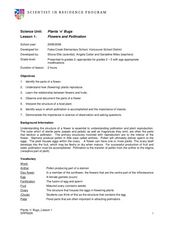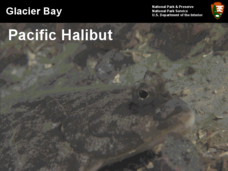Curated OER
Flowers and Pollination
Young scholars explore the environment by researching plant reproduction. In this pollination instructional activity, students define botany related vocabulary terms such as disc flower, petal and fertilization. Young scholars dissect a...
Curated OER
Experimentation with Teratogens on Zebrafish
Students compare mitosis and meiosis with regard to chromosome number in parent cells versus daughter cells, types of cells produced, total number of cells produced, and the number of divisions. In groups, identify and differentiate the...
Curated OER
Mendel and Meiosis
In this meiosis worksheet, students review vocabulary words associated with genetics, fertilization, heredity, phenotype and genotype. This worksheet has 6 matching and 9 fill in the blank questions.
Curated OER
Fishes
In this fish worksheet, students will review the characteristics of fish by comparing the jaws, skeleton, and fertilization of each fish class. Then students will use a phylogenetic tree to compare the groups of fish to ancestral...
Curated OER
Flower Reproduction
Fifth graders examine the cycle of flower reproduction. They listen to a poem about a bee, observe and examine flowers in small groups, and develop a class KWL chart. Students then read about flower reproduction in their textbook, and...
Curated OER
Sponges
In this sponges worksheet, students will explore the characteristics of sponges including their different types of cells and body structures. Students will also determine how sponges reproduce. This worksheet has 3 short answer and 11...
Curated OER
More on Meiosis
In this meiosis worksheet, students fill in the blank that describes the process of meiosis. Students also draw the process of meiosis.
Curated OER
Flowers and Reproduction
In this plant reproduction worksheet, students review the stages of the reproductive cycle of flowering plants. This worksheet has 1 matching, 1 short answer, and 1 true or false question.
Curated OER
Windows on Life
Students explore and observe living development using live fertilized chicken eggs. They open the eggs approximately 72 hrs after fertilization and make observations for several days.
Curated OER
Skates
Learners gain understanding of structure, characteristics, and basic needs of living things and their role in world, identify parts of skate, observe details of skate's body and skate egg case, and identify unique characteristics of skates.
Curated OER
Sexy Coral Reef and I Want My Own Space
Fifth graders explore how coral polyps increase the chances of egg and sperm meeting after being released into the vast ocean waters.
Curated OER
Comparative Embryology Using Japanese Medaka Fish
Young scholars conduct an experiment to control the breeding of Japanese Medaka fish. They collect the fertilized eggs and view and record the fish's embryological development daily to compare the stages to human development.
Curated OER
Making Twins
A short reading is accompanied by a quiz in a resource describing the differences between identical and fraternal twins. The quiz is mostly true/false and would make an excellent anticipatory set to get kids thinking about what they know...
Curated OER
Eighteen Ways to Make a Baby
Students view a video clip about post-menopausal women having children. They identify the ethical, legal and social implications of this. They also read a case study.
Curated OER
Dragon Genetics - Understanding Inheritance
Six pages begin with a detailed introduction to meiosis and homologous chromosome pairs. Instructions guide learners through a simulation in which they draw craft sticks marked with autosomes in order to decode the genes inherited by...
Biology Junction
Introduction to Animals
Out of all animals, elephants alone lack the ability to jump. Scholars learn all about animals using a presentation full of fun examples. It describes different types of animals, the biological similarities and differences between...
Garden Earth Naturalist Club
Parts of a Flower! Flower Dissection
Sometimes the best way to learn about plants is to see the different parts of a plant yourself. Groups of learners dissect flowers to answer questions about what they observe and what they wonder about their flower.
Curated OER
Fantastic Flower
Here is a clever lesson plan on pollination of flowers for you. In it, learners study the anatomy of a flower, and play a game in which they simulate the process of pollination. This fine plan brings in elements of art, physical...
Curated OER
Glacier Bay Pacific Halibut
The National Park Service has produced a high-quality presentation on the halibut population of Glacier Bay, Alaska. It takes the viewpoint of the marine biologists or rather, ichthyologists, who have been studying the adaptations,...
American Museum of Natural History
You are the Queen
A day in the life of a wasp queen is not as royal as it may sound. Pupils assume the role of the wasp queen to complete an interactive activity that simulates building a colony. They make decisions along the way and note the changes from...
Biology Junction
Introduction to Biology
Welcome to Biology! Introduce pupils to a subject conceptualized by Aristotle in 300 BC through a presentation and worksheet. It covers the themes of biology, characteristics of life, the scientific method, microscopes, and measurements.
Curated OER
LP 6--8: Xenopus laevis (frog) Development for a 7th Grade Audience
Seventh graders view lab stations with Xenopus at different stages of development. They identify the life stage of the sample, as well as the previous and next stages. Students must explain their reason for selecting the specific stage.
Curated OER
Fruit Fly Ranch Activity
Seventh graders describe how the traits of an organism are passed from generation to generation. They distinguish between asexual and sexul reproduction. Students identify traits through genes and those resulting from interactions with...
University of Wisconsin
Identifying Your Soil for Rain Gardens
Teach your class the descriptive characteristics of soil. Provide information about particle size and a flow chart for assessing texture. Soil scientists then analyze samples and hypothesize which would be the best type for a rain...

























